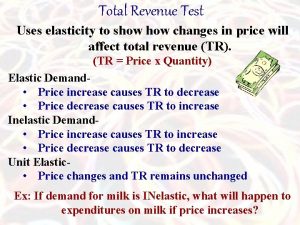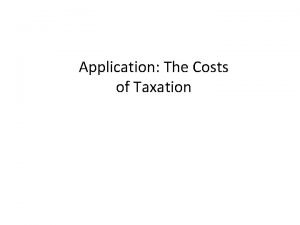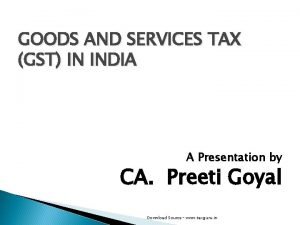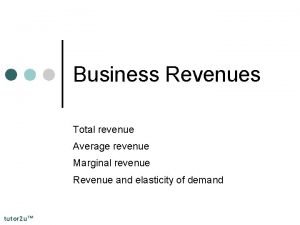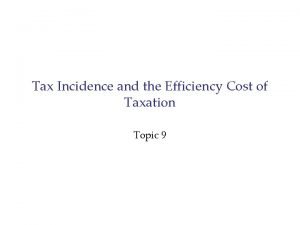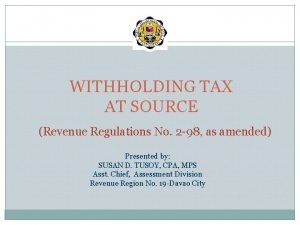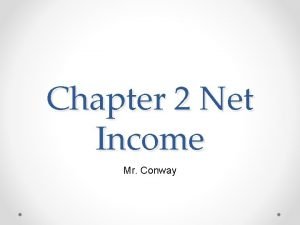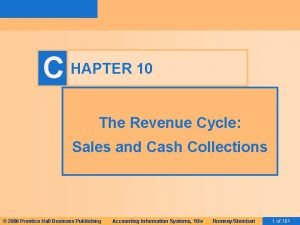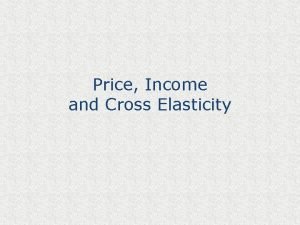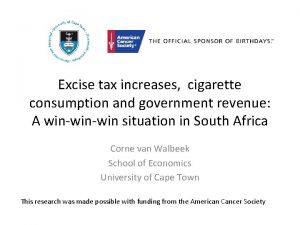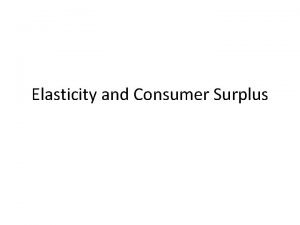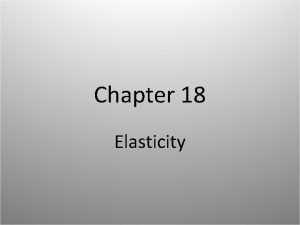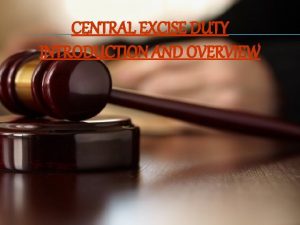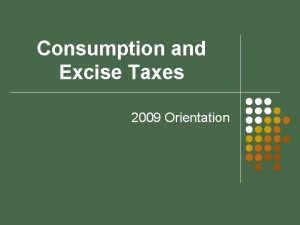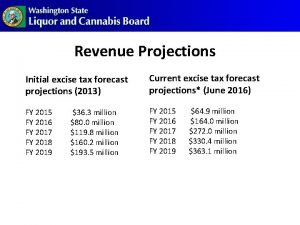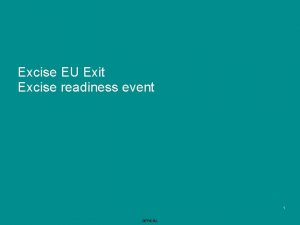Elasticity and Government Excise Tax Revenue Activity 21

















- Slides: 17

Elasticity and Government Excise Tax Revenue Activity 21

Remember this exercise: with the elasticity of demand for the good similar to the elasticity of supply. 50 What is the equilibrium price? $. 25 . 45 What is the equilibrium quantity? 200 . 40. 35 S . 30 What is the consumer surplus at equilibrium? ((. 45 -. 25)x 200)/2 = 20 What is the producer surplus at equilibrium? ((. 25 -. 05)x 200)/2 = 20 . 25. 20. 15 Assuming this is a competitive market, In what way is this efficient? Consumer and Producer Surplus are equal and at their maximum MSB = MSC D . 10. 05 50 100 150 200 250 300

Now let’s put that tax in place What is the new equilibrium price? $. 325 What is the new equilibrium quantity? 125 . 50. 45 S 1 . 40. 35 S . 30. 25. 20. 15 D . 10. 05 50 100 150 200 250 300 What is the consumer surplus at the new equilibrium? . 45 -. 32. 5=. 125 (. 125 x 125)/2 = $9. 375 What is the producer surplus at the new equilibrium? . 175 -. 05=. 125 (. 125 x 125)/2 = $9. 375 Assuming this is a competitive market, In what way is this efficient? It’s not!!! Although consumer and producer surplus are equal, 75 units of output are lost

Total Revenue or Px. Q = $50. 00 (. 25 x 200) at initial equilibrium. 50. 45. 40 supply . 35. 30. 25. 20. 15 demand Total revenue received by sellers At equilibrium . 10. 05 50 100 150 200 250 300

After Government Excise Tax of $. 15, total revenue(. 325 x 125)=$40. 625. 50 S 1 supply+tax . 45. 40 supply . 35. 30. 25 $40. 625 Total Revenue available after tax is levied; . 20 $. 25 x 75 = 18. 75 . 15. 10 lost revenue to the sellers is $50 - 21. 875 = $28. 125. 05 Less the $9. 375 tax paid = $18. 75 50 100 demand uncollected 150 200 250 300

Government Excise Tax Revenue = $18. 75 (. 15 x 125). 50 S 1 supply+tax . 45. 40. 35. 30. 25 Consumers pay. 075 in higher prices (. 325 -. 25) supply Or a total of$9. 375 of the tax Government Excise Tax Revenue = $18. 75 ((. 325 -. 175)x 125) or (. 15 x 125) . 20. 15 Sellers pay. 075 in the form of lost revenue (. 25 -. 175) . 10 Or a total of $9. 375 of the tax demand . 05 50 100 150 200 250 300

PART A (Figure 21. 3) Relatively Inelastic Demand to Supply. 50 S 1 supply+tax . 45. 40 supply . 35. 30. 25. 20 demand . 15. 10. 05 50 100 150 200 250 300

PART A (Figure 21. 3) Relatively Inelastic Demand to Supply. 50 S 1 supply+tax . 45. 40 supply . 35. 30 $52. 5 Total Revenue available after tax is levied; . 25 revenue gained is. 20 $52. 0 - 50 = $2. 5 lost revenue to the sellers is. 15 $50 - 30 = $20. 00 Less the $7. 5 tax paid = $12. 5. 10. 05 demand $. 25 x 75 = 12. 5 uncollected 50 100 150 200 250 300

PART A (Figure 21. 3) Relatively Inelastic Demand to Supply. 50. 45. 40 S 1 supply+tax Consumers pay. 10 in higher prices (. 35 -. 25) Or a total of$15. 00 of the tax supply . 35. 30. 25 Government Excise Tax Revenue = $22. 50 ((. 35 -. 20)x 150) or (. 15 x 150) . 20. 15 Sellers pay. 075 in the form of lost revenue (. 25 -. 175) demand Or a total of $7. 50 of the tax. 10. 05 50 100 150 200 250 300

PART B (Figure 21. 4) Relatively Elastic Demand to Supply. 50 S 1 supply+tax . 45. 40 supply . 35. 30. 25 demand . 20. 15. 10. 05 50 100 150 200 250 300

PART B (Figure 21. 4) Relatively Elastic Demand to Supply. 50 S 1 supply+tax . 45. 40. 35 Consumers pay. 05 in higher prices (. 30 -. 25) Or a total of$5. 00 of the tax supply . 30. 25 Government Excise Tax Revenue = $15. 00. 20 ((. 30 -. 15)x 150) or (. 15 x 100) demand . 15 Sellers pay. 10 in the form of lost revenue (. 25 -. 15) . 10 Or a total of $10 of the tax. 05 50 100 150 200 250 300

PART B (Figure 21. 4) Relatively Elastic Demand to Supply. 50 S 1 supply+tax . 45. 40 supply . 35. 30. 25. 20 $30. Total Revenue demand available after tax is levied; . 15 lost revenue to the. 10 sellers is $50 - 15 = $35. 05 Less the $10 tax paid = $25 50 100 $. 25 x 100 = $25 uncollected 150 200 250 300

PART C (Figure 21. 5) Perfectly Inelastic Demand. 50 S 1 supply+tax . 45. 40 supply . 35. 30. 25. 20. 15. 10 demand . 05 50 100 150 200 250 300

PART C (Figure 21. 5) Perfectly Inelastic Demand. 50 Consumers pay. 15 in higher prices (. 40 -. 25) S 1 supply+tax . 45 Or a total of$30. of the tax. 40. 35. 30 supply Government Excise Tax Revenue = $30 ((. 40 -. 25)x 200) or (. 15 x 200) . 25. 20 Sellers pay 0 in the form of lost revenue . 15 Or $0 of the tax . 10. 05 $80 Total Revenue available after tax is levied; demand 0 is uncollected 50 100 150 200 250 300

PART D (Figure 21. 6) Perfectly Elastic Demand. 50 S 1 supply+tax . 45. 40 supply . 35. 30. 25 demand . 20. 15. 10. 05 50 100 150 200 250 300

PART D (Figure 21. 6) Perfectly Elastic Demand. 50 S 1 supply+tax . 45. 40. 35 Consumers pay 0 in higher prices Or a total of $0 of the tax supply . 30. 25. 20. 15. 10 demand Government Excise Tax Revenue = $7. 5 ((. 25 -. 15)x 50) Sellers pay $7. 5 in the form of lost revenue or (. 15 x 50) ((. 25 -. 10)x 50). 05 Or a total of all $7. 5 of the tax 50 100 150 200 250 300

PART D (Figure 21. 6) Perfectly Elastic Demand. 50 S 1 supply+tax . 45. 40 supply . 35. 30. 25. 20. 15. 10. 05 $12. 5 Total Revenue available after tax is levied; lost revenue to the sellers is $50 - 5 = $45 Less the $5 tax paid = $37. 5 50 demand $. 25 x 150 = $37. 5 uncollected 100 150 200 250 300
 Ecommerce-portal of central board of excise and customs
Ecommerce-portal of central board of excise and customs British mercantilism
British mercantilism The bostonians paying the excise-man
The bostonians paying the excise-man Bostonians paying the excise man
Bostonians paying the excise man The total revenue test for elasticity
The total revenue test for elasticity Deadweight loss
Deadweight loss Conclusion on gst
Conclusion on gst Average revenue vs marginal revenue
Average revenue vs marginal revenue How to find the tax revenue
How to find the tax revenue Withholding tax form 2307
Withholding tax form 2307 Find the local tax deducted: $456 biweekly, 2 1/2 % tax.
Find the local tax deducted: $456 biweekly, 2 1/2 % tax. Federal government primary source of revenue
Federal government primary source of revenue Is not a basic activity of the revenue cycle
Is not a basic activity of the revenue cycle National powers
National powers Activity and activity coefficient
Activity and activity coefficient Guided reading activity foundations of government lesson 1
Guided reading activity foundations of government lesson 1 Elasticity
Elasticity Price and income elasticity
Price and income elasticity




